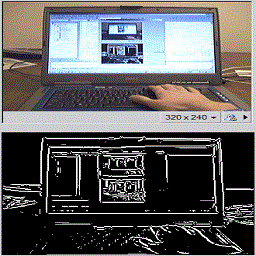الگوریتم Canny در زبان c
الگوریتم Canny
لبه یاب کنی توسط جان اف کنی در سال 1986 ایجاد شد و هنوز یک لبه یاب استاندارد و با دقت و کیفیت بالا میباشد.الگوریتم لبه یابی کنی یکی از بهترین لبه یابها تا به امروز است. در ادامه روش کار این الگوریتم و هم چنین کد الگوریتم Canny در C را بررسی خواهیم کرد. این الگوریتم لبه یابی از سه بخش اصلی زیر تشکیل شده است:
- تضعیف نویز
- پیدا کردن نقاطی که بتوان آنها را به عنوان لبه در نظر گرفت
- جذب نقاطی که احتمال لبه بودن آنها کم است
معیارهایی که در لبه یاب کنی مطرح می باشد:
1 -پایین آوردن نرخ خطا- یعنی تا حد امکان هیچ لبه ای در تصویر نباید گم شود و هم چنین هیچ چیزی که لبه نیست نباید به جای لبه فرض شود. لبه هان پیدا شده تا حد ممکن به لبه ها اصلی
نزدیک باشند.
2 -لبه در مکان واقعی خود باشد- یعنی تا حد ممکن لبه ها کمترین فاصله را با مکان واقعی خود داشته باشند.
3 -بران هر لبه فقط یک پاسخ داشته باشیم.
4 -لبه ها کمترین ضخامت را داشته باشند- (در صورت امکان یک پیکسل).
لبه یاب کنی بخاطر توانایی در تولید لبه های نازک تا حد یک ییکسل برای لبه های پیوسته معروف شده است. این لبه یاب شامل چهار مرحله و چهار ورودی زیر است:
یک تصویر ورودی
یک پارامتر به نام سیگما جهت مقدار نرم کنندگی تصویر
یک حد آستانه بالا (Th)
یک حد آستانه پایین (Tl)
مراحل الگوریتم Canny:
1- در ابتدا باید تصویر رنگی را به جهت لبه یابی بهتر به یک تصویر سطح خاکسترن تبدیب کرد.
2- نویز را از تصویر دریافتی حذف کرد. بدلیل اینکه فیلتر گاوسین از یک ماسک ساده برای حذف نویز استفاده می کند لبه یاب کنی در مرحله اول برای حذف نویز آن را بکار می گیرد.
3- در یک تصویر سطح خاکستر جایی را که بیشترین تغییرات را داشته باشند به عنوان لبه در نظر گرفته می شوند و این مکانها با گرفتن گرادیان تصویر با استفاده عملگر سوبل بدست می آیند. سپس لبه های مات یافت شده به لبه های تیزتر تبدیل می شوند.
4- برخی از لبه های کشف شده واقعا لبه نیستند و در واقع نویز هستند که باید آنها توسط حد آستانه هیسترزیس فیلتر شوند.هیسترزیس از دو حد آستانه بالاتر (Th) و حد آستانه پایین تر (Tl) استفاده کرده و کنی پیشنهاد می کند که نسبت استانه بالا به پایین سه به یک باشد.
این روش بیشتر به کشف لبه های ضعیف به درستی می پردازد و کمتر فریب نویز را می خورد و از بقیه روش ها بهتر است.


کد الگوریتم Canny در C :
برنامه زیر یک فایل BMP سیاه و سفید 8 بیت در هر پیکسل را می خواند و نتیجه را در ‘out.bmp’ ذخیره می کند.با `-lm ‘ کامپایل می شود.
#include <stdint.h>
#include <stdio.h>
#include <stdlib.h>
#include <float.h>
#include <math.h>
#include <string.h>
#include <stdbool.h>
#include <assert.h>
#define MAX_BRIGHTNESS 255
// C99 doesn't define M_PI (GNU-C99 does)
#define M_PI 3.14159265358979323846264338327
/*
* Loading part taken from
* http://www.vbforums.com/showthread.php?t=261522
* BMP info:
* http://en.wikipedia.org/wiki/BMP_file_format
*
* Note: the magic number has been removed from the bmpfile_header_t
* structure since it causes alignment problems
* bmpfile_magic_t should be written/read first
* followed by the
* bmpfile_header_t
* [this avoids compiler-specific alignment pragmas etc.]
*/
typedef struct {
uint8_t magic[2];
} bmpfile_magic_t;
typedef struct {
uint32_t filesz;
uint16_t creator1;
uint16_t creator2;
uint32_t bmp_offset;
} bmpfile_header_t;
typedef struct {
uint32_t header_sz;
int32_t width;
int32_t height;
uint16_t nplanes;
uint16_t bitspp;
uint32_t compress_type;
uint32_t bmp_bytesz;
int32_t hres;
int32_t vres;
uint32_t ncolors;
uint32_t nimpcolors;
} bitmap_info_header_t;
typedef struct {
uint8_t r;
uint8_t g;
uint8_t b;
uint8_t nothing;
} rgb_t;
// Use short int instead `unsigned char' so that we can
// store negative values.
typedef short int pixel_t;
pixel_t *load_bmp(const char *filename,
bitmap_info_header_t *bitmapInfoHeader)
{
FILE *filePtr = fopen(filename, "rb");
if (filePtr == NULL) {
perror("fopen()");
return NULL;
}
bmpfile_magic_t mag;
if (fread(&mag, sizeof(bmpfile_magic_t), 1, filePtr) != 1) {
fclose(filePtr);
return NULL;
}
// verify that this is a bmp file by check bitmap id
// warning: dereferencing type-punned pointer will break
// strict-aliasing rules [-Wstrict-aliasing]
if (*((uint16_t*)mag.magic) != 0x4D42) {
fprintf(stderr, "Not a BMP file: magic=%c%c\n",
mag.magic[0], mag.magic[1]);
fclose(filePtr);
return NULL;
}
bmpfile_header_t bitmapFileHeader; // our bitmap file header
// read the bitmap file header
if (fread(&bitmapFileHeader, sizeof(bmpfile_header_t),
1, filePtr) != 1) {
fclose(filePtr);
return NULL;
}
// read the bitmap info header
if (fread(bitmapInfoHeader, sizeof(bitmap_info_header_t),
1, filePtr) != 1) {
fclose(filePtr);
return NULL;
}
if (bitmapInfoHeader->compress_type != 0)
fprintf(stderr, "Warning, compression is not supported.\n");
// move file point to the beginning of bitmap data
if (fseek(filePtr, bitmapFileHeader.bmp_offset, SEEK_SET)) {
fclose(filePtr);
return NULL;
}
// allocate enough memory for the bitmap image data
pixel_t *bitmapImage = malloc(bitmapInfoHeader->bmp_bytesz *
sizeof(pixel_t));
// verify memory allocation
if (bitmapImage == NULL) {
fclose(filePtr);
return NULL;
}
// read in the bitmap image data
size_t pad, count=0;
unsigned char c;
pad = 4*ceil(bitmapInfoHeader->bitspp*bitmapInfoHeader->width/32.) - bitmapInfoHeader->width;
for(size_t i=0; i<bitmapInfoHeader->height; i++){
for(size_t j=0; j<bitmapInfoHeader->width; j++){
if (fread(&c, sizeof(unsigned char), 1, filePtr) != 1) {
fclose(filePtr);
return NULL;
}
bitmapImage[count++] = (pixel_t) c;
}
fseek(filePtr, pad, SEEK_CUR);
}
// If we were using unsigned char as pixel_t, then:
// fread(bitmapImage, 1, bitmapInfoHeader->bmp_bytesz, filePtr);
// close file and return bitmap image data
fclose(filePtr);
return bitmapImage;
}
// Return: true on error.
bool save_bmp(const char *filename, const bitmap_info_header_t *bmp_ih,
const pixel_t *data)
{
FILE* filePtr = fopen(filename, "wb");
if (filePtr == NULL)
return true;
bmpfile_magic_t mag = {{0x42, 0x4d}};
if (fwrite(&mag, sizeof(bmpfile_magic_t), 1, filePtr) != 1) {
fclose(filePtr);
return true;
}
const uint32_t offset = sizeof(bmpfile_magic_t) +
sizeof(bmpfile_header_t) +
sizeof(bitmap_info_header_t) +
((1U << bmp_ih->bitspp) * 4);
const bmpfile_header_t bmp_fh = {
.filesz = offset + bmp_ih->bmp_bytesz,
.creator1 = 0,
.creator2 = 0,
.bmp_offset = offset
};
if (fwrite(&bmp_fh, sizeof(bmpfile_header_t), 1, filePtr) != 1) {
fclose(filePtr);
return true;
}
if (fwrite(bmp_ih, sizeof(bitmap_info_header_t), 1, filePtr) != 1) {
fclose(filePtr);
return true;
}
// Palette
for (size_t i = 0; i < (1U << bmp_ih->bitspp); i++) {
const rgb_t color = {(uint8_t)i, (uint8_t)i, (uint8_t)i};
if (fwrite(&color, sizeof(rgb_t), 1, filePtr) != 1) {
fclose(filePtr);
return true;
}
}
// We use int instead of uchar, so we can't write img
// in 1 call any more.
// fwrite(data, 1, bmp_ih->bmp_bytesz, filePtr);
// Padding: http://en.wikipedia.org/wiki/BMP_file_format#Pixel_storage
size_t pad = 4*ceil(bmp_ih->bitspp*bmp_ih->width/32.) - bmp_ih->width;
unsigned char c;
for(size_t i=0; i < bmp_ih->height; i++) {
for(size_t j=0; j < bmp_ih->width; j++) {
c = (unsigned char) data[j + bmp_ih->width*i];
if (fwrite(&c, sizeof(char), 1, filePtr) != 1) {
fclose(filePtr);
return true;
}
}
c = 0;
for(size_t j=0; j<pad; j++)
if (fwrite(&c, sizeof(char), 1, filePtr) != 1) {
fclose(filePtr);
return true;
}
}
fclose(filePtr);
return false;
}
// if normalize is true, map pixels to range 0..MAX_BRIGHTNESS
void convolution(const pixel_t *in, pixel_t *out, const float *kernel,
const int nx, const int ny, const int kn,
const bool normalize)
{
assert(kn % 2 == 1);
assert(nx > kn && ny > kn);
const int khalf = kn / 2;
float min = FLT_MAX, max = -FLT_MAX;
if (normalize)
for (int m = khalf; m < nx - khalf; m++)
for (int n = khalf; n < ny - khalf; n++) {
float pixel = 0.0;
size_t c = 0;
for (int j = -khalf; j <= khalf; j++)
for (int i = -khalf; i <= khalf; i++) {
pixel += in[(n - j) * nx + m - i] * kernel;
c++;
}
if (pixel < min)
min = pixel;
if (pixel > max)
max = pixel;
}
for (int m = khalf; m < nx - khalf; m++)
for (int n = khalf; n < ny - khalf; n++) {
float pixel = 0.0;
size_t c = 0;
for (int j = -khalf; j <= khalf; j++)
for (int i = -khalf; i <= khalf; i++) {
pixel += in[(n - j) * nx + m - i] * kernel;
c++;
}
if (normalize)
pixel = MAX_BRIGHTNESS * (pixel - min) / (max - min);
out[n * nx + m] = (pixel_t)pixel;
}
}
/*
* gaussianFilter:
* http://www.songho.ca/dsp/cannyedge/cannyedge.html
* determine size of kernel (odd #)
* 0.0 <= sigma < 0.5 : 3
* 0.5 <= sigma < 1.0 : 5
* 1.0 <= sigma < 1.5 : 7
* 1.5 <= sigma < 2.0 : 9
* 2.0 <= sigma < 2.5 : 11
* 2.5 <= sigma < 3.0 : 13 ...
* kernelSize = 2 * int(2*sigma) + 3;
*/
void gaussian_filter(const pixel_t *in, pixel_t *out,
const int nx, const int ny, const float sigma)
{
const int n = 2 * (int)(2 * sigma) + 3;
const float mean = (float)floor(n / 2.0);
float kernel[n * n]; // variable length array
fprintf(stderr, "gaussian_filter: kernel size %d, sigma=%g\n",
n, sigma);
size_t c = 0;
for (int i = 0; i < n; i++)
for (int j = 0; j < n; j++) {
kernel = exp(-0.5 * (pow((i - mean) / sigma, 2.0) +
pow((j - mean) / sigma, 2.0)))
/ (2 * M_PI * sigma * sigma);
c++;
}
convolution(in, out, kernel, nx, ny, n, true);
}
/*
* Links:
* http://en.wikipedia.org/wiki/Canny_edge_detector
* http://www.tomgibara.com/computer-vision/CannyEdgeDetector.java
* http://fourier.eng.hmc.edu/e161/lectures/canny/node1.html
* http://www.songho.ca/dsp/cannyedge/cannyedge.html
*
* Note: T1 and T2 are lower and upper thresholds.
*/
pixel_t *canny_edge_detection(const pixel_t *in,
const bitmap_info_header_t *bmp_ih,
const int tmin, const int tmax,
const float sigma)
{
const int nx = bmp_ih->width;
const int ny = bmp_ih->height;
pixel_t *G = calloc(nx * ny * sizeof(pixel_t), 1);
pixel_t *after_Gx = calloc(nx * ny * sizeof(pixel_t), 1);
pixel_t *after_Gy = calloc(nx * ny * sizeof(pixel_t), 1);
pixel_t *nms = calloc(nx * ny * sizeof(pixel_t), 1);
pixel_t *out = malloc(bmp_ih->bmp_bytesz * sizeof(pixel_t));
if (G == NULL || after_Gx == NULL || after_Gy == NULL ||
nms == NULL || out == NULL) {
fprintf(stderr, "canny_edge_detection:"
" Failed memory allocation(s).\n");
exit(1);
}
gaussian_filter(in, out, nx, ny, sigma);
const float Gx[] = {-1, 0, 1,
-2, 0, 2,
-1, 0, 1};
convolution(out, after_Gx, Gx, nx, ny, 3, false);
const float Gy[] = { 1, 2, 1,
0, 0, 0,
-1,-2,-1};
convolution(out, after_Gy, Gy, nx, ny, 3, false);
for (int i = 1; i < nx - 1; i++)
for (int j = 1; j < ny - 1; j++) {
const int c = i + nx * j;
// G = abs(after_Gx) + abs(after_Gy);
G = (pixel_t)hypot(after_Gx, after_Gy);
}
// Non-maximum suppression, straightforward implementation.
for (int i = 1; i < nx - 1; i++)
for (int j = 1; j < ny - 1; j++) {
const int c = i + nx * j;
const int nn = c - nx;
const int ss = c + nx;
const int ww = c + 1;
const int ee = c - 1;
const int nw = nn + 1;
const int ne = nn - 1;
const int sw = ss + 1;
const int se = ss - 1;
const float dir = (float)(fmod(atan2(after_Gy,
after_Gx) + M_PI,
M_PI) / M_PI) * 8;
if (((dir <= 1 || dir > 7) && G > G[ee] &&
G > G[ww]) || // 0 deg
((dir > 1 && dir <= 3) && G > G[nw] &&
G > G[se]) || // 45 deg
((dir > 3 && dir <= 5) && G > G[nn] &&
G > G[ss]) || // 90 deg
((dir > 5 && dir <= 7) && G > G[ne] &&
G > G[sw])) // 135 deg
nms = G;
else
nms = 0;
}
// Reuse array
// used as a stack. nx*ny/2 elements should be enough.
int *edges = (int*) after_Gy;
memset(out, 0, sizeof(pixel_t) * nx * ny);
memset(edges, 0, sizeof(pixel_t) * nx * ny);
// Tracing edges with hysteresis . Non-recursive implementation.
size_t c = 1;
for (int j = 1; j < ny - 1; j++)
for (int i = 1; i < nx - 1; i++) {
if (nms >= tmax && out == 0) { // trace edges
out = MAX_BRIGHTNESS;
int nedges = 1;
edges[0] = c;
do {
nedges--;
const int t = edges[nedges];
int nbs[8]; // neighbours
nbs[0] = t - nx; // nn
nbs[1] = t + nx; // ss
nbs[2] = t + 1; // ww
nbs[3] = t - 1; // ee
nbs[4] = nbs[0] + 1; // nw
nbs[5] = nbs[0] - 1; // ne
nbs[6] = nbs[1] + 1; // sw
nbs[7] = nbs[1] - 1; // se
for (int k = 0; k < 8; k++)
if (nms[nbs[k]] >= tmin && out[nbs[k]] == 0) {
out[nbs[k]] = MAX_BRIGHTNESS;
edges[nedges] = nbs[k];
nedges++;
}
} while (nedges > 0);
}
c++;
}
free(after_Gx);
free(after_Gy);
free(G);
free(nms);
return out;
}
int main(const int argc, const char ** const argv)
{
if (argc < 2) {
printf("Usage: %s image.bmp\n", argv[0]);
return 1;
}
static bitmap_info_header_t ih;
const pixel_t *in_bitmap_data = load_bmp(argv[1], &ih);
if (in_bitmap_data == NULL) {
fprintf(stderr, "main: BMP image not loaded.\n");
return 1;
}
printf("Info: %d x %d x %d\n", ih.width, ih.height, ih.bitspp);
const pixel_t *out_bitmap_data =
canny_edge_detection(in_bitmap_data, &ih, 45, 50, 1.0f);
if (out_bitmap_data == NULL) {
fprintf(stderr, "main: failed canny_edge_detection.\n");
return 1;
}
if (save_bmp("out.bmp", &ih, out_bitmap_data)) {
fprintf(stderr, "main: BMP image not saved.\n");
return 1;
}
free((pixel_t*)in_bitmap_data);
free((pixel_t*)out_bitmap_data);
return 0;
}
دانلود کد فوق از طریق لینک زیر:




دیدگاه خود را ثبت کنید
تمایل دارید در گفتگوها شرکت کنید؟در گفتگو ها شرکت کنید.